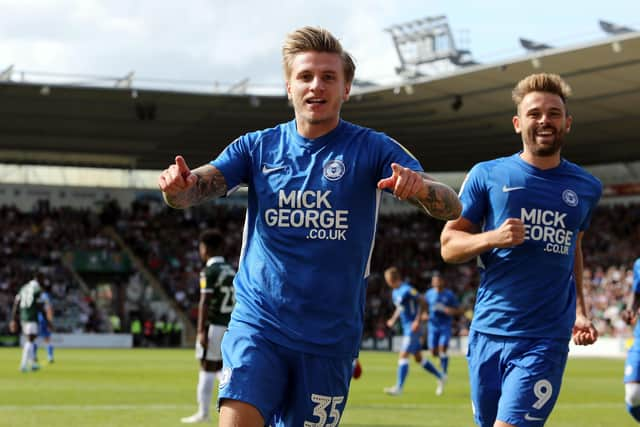Peterborough United: A statistical look at recent failures to return to the Championship. Part four: 2018-19 season. ‘Long balls & unsustainable overperformance followed by an ever-changing gameplan’


Data is only readily available for the last five seasons so we will cover a season a day from Monday to Friday. Today (September 8) James covers the 2018-19 campaign.
Key:
Expected Goals (xG): A model which measures the likelihood of any individual shot being scored, with 1 being a 100% chance of scoring and 0 being a 0% chance of scoring. It takes into account factors such as angle, distance and body part of the shot taken.


Advertisement
Hide AdAdvertisement
Hide AdExpected goals against (xGA): As above but for shots conceded.
Expected Points (xP): The number of points a side would have collected if the side who had the better chances to score had won, based on each team’s xG data.
Per 90 (p90): How often a team or player performs a certain action every 90 minutes of game time.
Key Pass: A pass or cross which creates a clear situation or opportunity for a goal but the receiving player misses this chance.
Advertisement
Hide AdAdvertisement
Hide AdDeep Completion: A successful pass (not cross) that finishes within 20m of the opposition goal.
‘Long balls & unsustainable overperformance followed by an ever-changing gameplan’
The 2018/19 season saw a dramatic shift in terms of style of play following the appointment of Steve Evans as manager towards the end of the 2017/18 season. From 2015 to the present date Posh have, to varying extents, been a side who favour a short passing game. That changed under Evans, with a clear shift towards a more direct style of play. Posh started playing fewer passes per game while the percentage of long passes, forward passes and counter attacks increased significantly.
There is nothing wrong with playing direct or counter-attacking football. Anyone who has seen such a style played well will know how exciting and effective it can be. The issue was that Posh just weren’t very effective at the things they did the most. They countered more than any other Posh side between 2015-2020 but were the least efficient at it. They played forwards more regularly than other Posh sides, but were again by the far least accurate in this regard, suggesting that they often rushed play and conceded possession too regularly.
Advertisement
Hide AdAdvertisement
Hide AdSome people will point to the excellent results Evans achieved at the start of his Posh career as a counter-argument for the fact his style could have been effective that season. However, when we look at the underlying performance data, we can see that Posh were enjoying a rather large, flattering and unsustainable over-performance in terms of results compared to the performances they were putting in.
Posh picked up 15 more points than expected between August and October. For the rest of the season results regressed and roughly averaged out with what was expected with Posh collecting just two fewer points than expected.
It’s important to explain here a valid criticism of xG models and acknowledge that using an xG analysis isn’t perfect. Some managers employ systems which allow them to out-perform xG models on a regular and sustained basis. For example, Sean Dyche’s Burnley over-perform year after year compared to their expected performance on such models, in part due to their ability to defend their own box superbly and execute an incredibly high number of blocks. This is something Posh themselves were very adept at when they had Gabby Zakuani throwing his body at everything that moved.
In such a case, we can say with confidence that Dyche has devised a playing model which highlights a weakness in the xG models currently available. Burnley’s overperformance is not lucky, but rather reflects that xG models need to become smarter to account for the aspects of play which they are very good at.
Advertisement
Hide AdAdvertisement
Hide AdSadly, this is not the case with Evans’ playing style. His 2019/20 Gillingham side underperformed in terms of goals to xG and were pretty much in line with their goals conceded to xGA data, while it was a similar story for Evans at Mansfield Town before joining Posh. Evans, rather than devising a system which outsmarted the models available, was simply lucky at the start of the season. He had two forwards, in Jason Cummings and Matt Godden, who hit an unsustainable hot streak in terms of finishing, while on a number of occasions Posh’s opponents would waste a number of very presentable scoring chances.
In a low scoring sport such as football, luck can play a huge part and sides can massively over or under achieve for short periods of time, although it is very rare that this will last over a prolonged period. In Evans’ case, his luck quickly ran out and he was sacked in January.
With Darren Ferguson back at the helm Posh performances were in line with that of a mid-table side. While this was not great, it was a significant improvement on the performances (if not results) under Evans. Under Fergie, Posh had an expected points per game of 1.35, averaged out over the course of the season this would give Posh 62 points (assuming results reflected performances) good enough for 10th. Under Evans, Posh had an expected points per game of just 1.24, which if maintained over the course of the season would have seen Posh finish 13th on 57 points.
Posh were therefore a middling League One side, who courtesy of some fortunate early season results found themselves battling for an unlikely play-off spot. They improved slightly under Fergie, but his reign that season was best characterised by the constant chopping and changing off both formation and tactical approach. In just 19 games, Posh played at least one match with each of the following as their primary formation: 4-1-2-1-2, 3-4-1-2, 3-5-2, 4-2-3-1, 4-4-2.
Advertisement
Hide AdAdvertisement
Hide AdIt was a similar story in terms of approach on the ball. Posh cycled between patient build-up play and a more direct, counter attacking style, with their approach being primarily dictated by the standard and style of opposition. Interestingly, when the pressure was on and Fergie needed to win the final two games of the season to have any chance of reaching the play-offs, his approach had a rather distinct Evans feel about it. Posh lined up 4-4-2, averaged just 282 passes at 2.39 passes per possession (269.3 and 2.35 under Evans), played 20.6% of passes long (24% under Evans), and averaged a whopping six counter attacks.
Finally, in a true homage to Evans, Posh lost the xG battle in both games and had fewer shots, but managed to win thanks to some clinical finishing. This was a far cry from Fergie’s first game back in charge against Bristol Rovers, whereby Posh made 559 passes at 4.7 passes per possession, just 11.4% of passes went long and had three counter attacks. It was essentially an admission from Ferguson that he had neither the players, nor time, to impose his style on the side.
Perhaps then, the most significant number that defined Posh’s 2018/19 season was 23; the number of players Posh owner Darragh MacAnthony allowed Evans to sign during his short spell in charge. When Evans didn’t work out and Fergie attempted to revert Posh back to a style of play more consistent with their time under MacAnthony, he was left with a squad which could not meet his needs.
Darragh and his ownership team learnt a valuable lesson about changing style of play at the whim of the current manager the hard way that season, hopefully it is a mistake which has since been addressed in terms of recruitment and long-term planning.